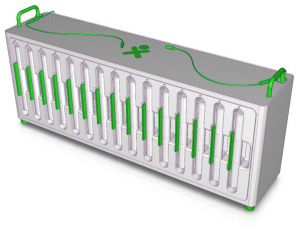Multi channel battery charger: Difference between revisions
Jump to navigation
Jump to search
m (remove Category:MBC, this is the only page in it.) |
|||
| (45 intermediate revisions by 10 users not shown) | |||
| Line 1: | Line 1: | ||
| ⚫ | |||
{{OLPC}} |
{{OLPC}} |
||
This page describes a charger for multiple [[Hardware#XO_Laptop|XO Laptop]] batteries. |
|||
{{draft}} |
|||
== Introduction == |
|||
= Multi Channel Battery Charger = |
|||
[[Image:Multi-Battery_Charger.png|300px|right]] |
|||
Code name "Supercharger" |
|||
See [[Product News]] for product availability. |
|||
== Input Power == |
|||
* AC Power 100V-230V. 300W |
|||
* DC 10V-28V. 150W |
|||
== |
== Exterior Connections == |
||
| ⚫ | |||
* 15 batteries per unit. |
|||
* DC In: 10VDC to 28VDC 2 Pin connector that mates with whats on the GP solar blanket. |
|||
* Charge batteries in 2 hours (Subject to limits per cycle time) |
|||
** DC connector is not yet finalized |
|||
* OLPC must own the entire design. |
|||
| ⚫ | |||
* 2 cables with XO DC jacks on them |
|||
== Electrical == |
== Electrical Misc == |
||
* The CPU will be and Atmel At91SAM7x family part. Either the 128 or 256 depending on how cheap we can get them in volume. |
|||
* The CPU is an Atmel At91SAM7x family part. |
|||
** See http://www.atmel.com/dyn/products/product_card.asp?part_id=3754 |
** See http://www.atmel.com/dyn/products/product_card.asp?part_id=3754 |
||
* The per battery DC-DC charger is a SEPIC design based around a MicroChip MCP1631 part |
|||
* Power source. AC 100V-230V. DC 9V-30V. The DC plug needs to be some sort of standard plug. Each battery needs 15W if its charged from totally empty. So 15 batteries is 225W. Meaning we will probably need a 300W power supply or so. 9VDC @ 300W means a 30 Amp connector. |
|||
=== Exterior devices === |
|||
| ⚫ | |||
* DC In: 9VDC to 30VDC 30Amp |
|||
** Bill is going to find us a few connectors to choose from. |
|||
* DB9 for RS-232 |
|||
| ⚫ | |||
* Power switch |
|||
** Need example switches |
|||
** In addition to the power switch we are also going to need some sort of circuit breaker on the input. Considering the different voltage/current ranges for AC vs DC there will probably need to be one for each supply. |
|||
* Two indicator lights per battery channel |
|||
** Red Led and Green Led. Use the same setup as in the laptop. Red, Green, and Yellow both are enabled. |
|||
* Battery Tray |
|||
* External laptop power DC cables. |
|||
** 2 of the XO DC power cables available to the kids so they they can power their laptops while they switch batteries. This keeps them from having to turn off the laptops to switch batteries. |
|||
* ''Future'' RJ45 10/100 ethernet connection |
|||
== Software == |
== Software == |
||
* will be updated soon |
|||
* Forth/C combination. |
|||
| ⚫ | |||
* http://dev.laptop.org/git/projects/supercharger |
|||
* Density. Getting as many batteries as possible in as small a footprint is a goal. |
|||
| ⚫ | |||
* Physical Safety. Its got to be stable and hold lots of heavy batteries but not be able to fall over on top of a child. Who might be trying to climb on it to get his battery. |
|||
* Approximately 2 hours for complete charge |
|||
** Maximum number of simultaneous charging channels |
|||
* Stackable. More vertical space is available than floor sq footage so an idea was to make them stackable. But see above point. |
|||
*** 15 Batteries on AC |
|||
*** 10 Batteries via 150W DC source |
|||
* Heat dissipation. Each battery needs 15W worst case and most of that power will be dissipated into the batery. I expect the electronics/battery to dissipate less than 1W/battery. PSU at 300W @ 85% efficiency is 45W. |
|||
*** 8 Batteries via 2 60W solar blankets |
|||
*** 4 Batteries via 1 60W blanket |
|||
* Enclosure. Metal. Except perhaps for some plastic for the battery holder. Having metal available to heatsink to should help in keeping the electronics from burning up in hot countries. |
|||
== Datasheets == |
== Datasheets == |
||
| Line 55: | Line 41: | ||
* [[Image:At91sam7x128_256_pc.pdf]] Atmel CPU |
* [[Image:At91sam7x128_256_pc.pdf]] Atmel CPU |
||
* [[Image:DS2756.pdf|DS2756]] DS2756 |
* [[Image:DS2756.pdf|DS2756]] DS2756 |
||
* 30A connector |
|||
[[Category:Peripherals]] |
|||
| ⚫ | |||
Latest revision as of 08:49, 14 March 2011
This page is monitored by the OLPC team.
This page describes a charger for multiple XO Laptop batteries.
Introduction
Code name "Supercharger"
Input Power
- AC Power 100V-230V. 300W
- DC 10V-28V. 150W
Exterior Connections
- AC In: IEC for 120/220VAC
- DC In: 10VDC to 28VDC 2 Pin connector that mates with whats on the GP solar blanket.
- DC connector is not yet finalized
- USB B connector (Its a USB device)
- 2 cables with XO DC jacks on them
Electrical Misc
- The CPU is an Atmel At91SAM7x family part.
- The per battery DC-DC charger is a SEPIC design based around a MicroChip MCP1631 part
Software
- Forth/C combination.
- http://dev.laptop.org/git/projects/supercharger
Function
- Approximately 2 hours for complete charge
- Maximum number of simultaneous charging channels
- 15 Batteries on AC
- 10 Batteries via 150W DC source
- 8 Batteries via 2 60W solar blankets
- 4 Batteries via 1 60W blanket
- Maximum number of simultaneous charging channels
Datasheets
- File:At91sam7x128 256 pc.pdf Atmel CPU
- File:DS2756.pdf DS2756
